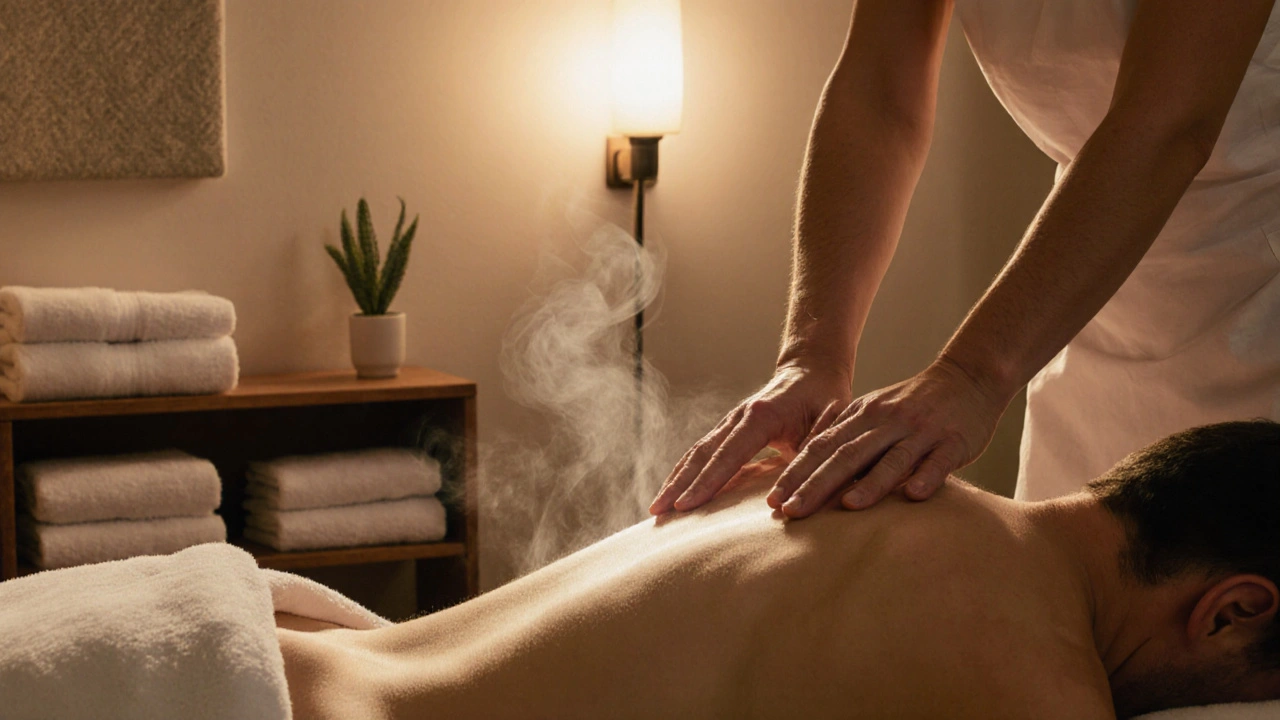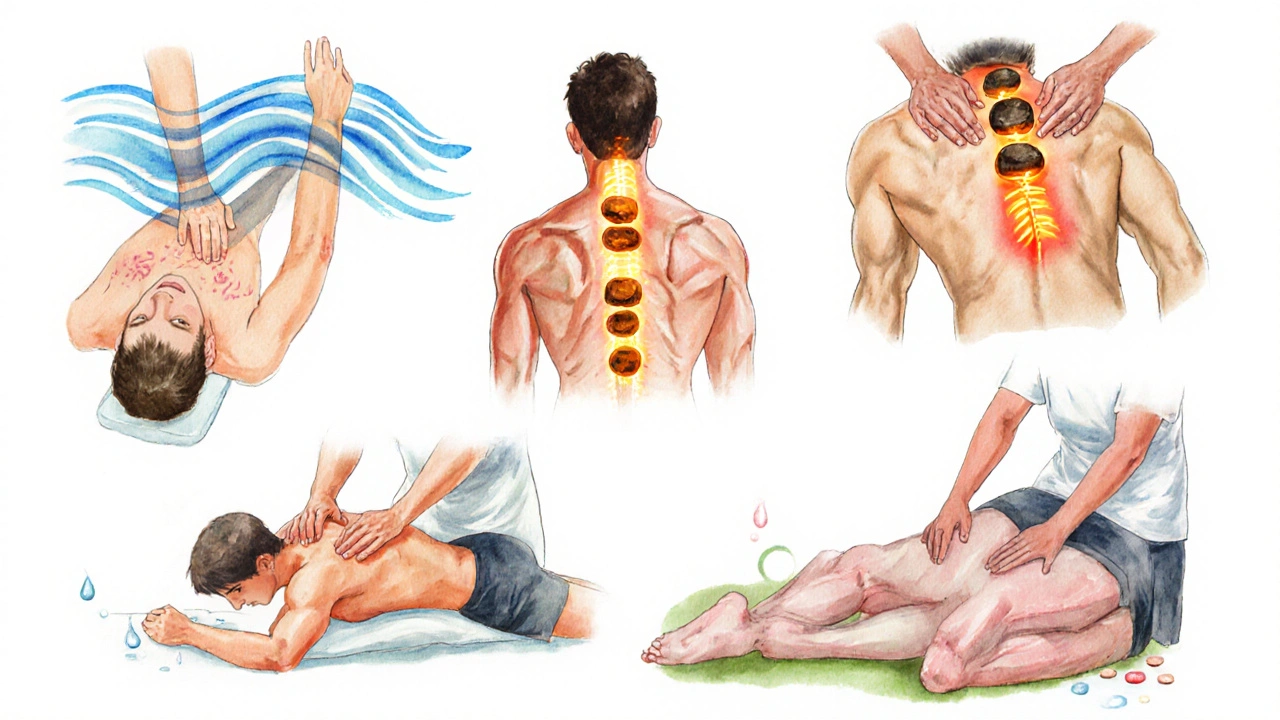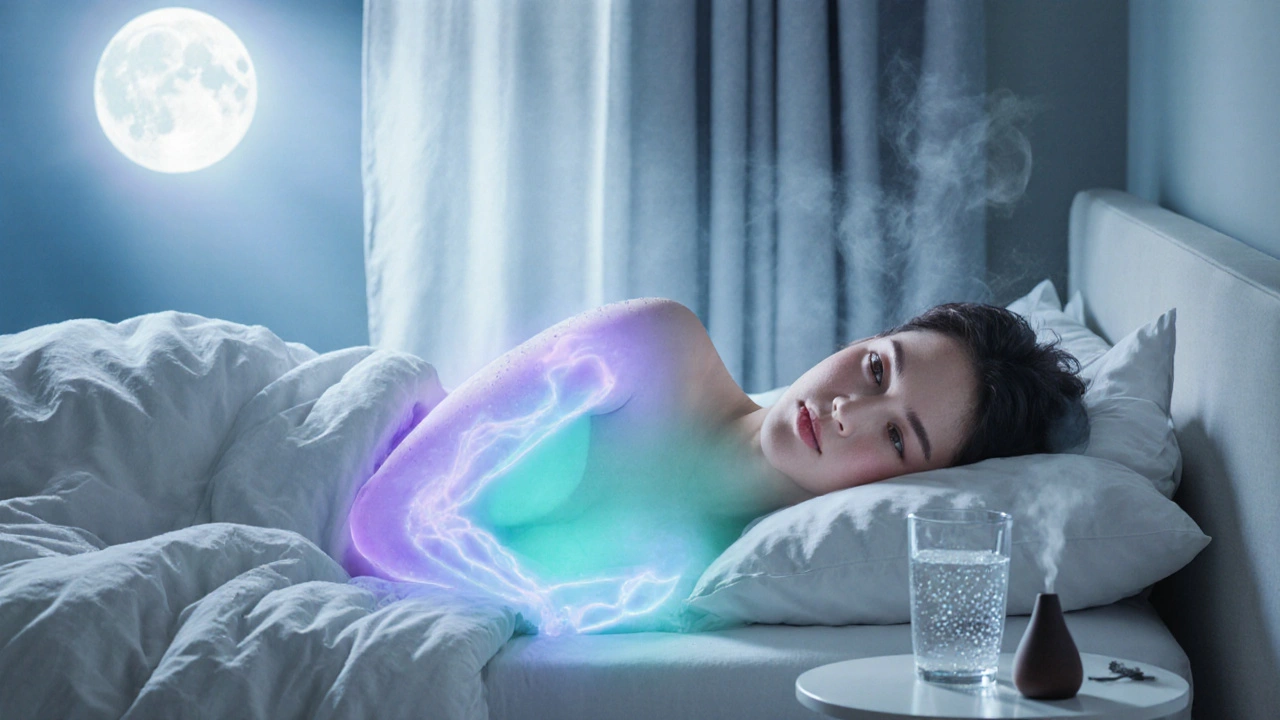Body Massage Types & Benefits - Complete Guide

Key Takeaways
- Body massage comes in many styles, each targeting specific needs.
- Swedish, deep‑tissue, hot‑stone, Thai, lymphatic drainage, aromatherapy, and sports massage are the most popular.
- Common benefits include stress relief, improved circulation, faster recovery, and better sleep.
- Choosing a therapist with proper credentials and clear communication ensures a safe experience.
- Typical session costs range from $60 to $130, depending on style and location.
Direct Answer
If you’re wondering what body massage types exist and how they help, the short answer is: there are at least seven widely practiced styles-Swedish, deep‑tissue, hot‑stone, Thai, lymphatic drainage, aromatherapy, and sports massage. Each one uses different techniques to relax muscles, boost circulation, reduce tension, and support overall wellness.
Comprehensive Guide to Body Massage
Imagine stepping into a quiet room, the scent of essential oils swirling in the air, and a skilled therapist’s hands working out the knots you didn’t even know were there. That’s the promise of a good body massage, and it’s why millions of people book sessions every week. This guide walks you through the most common massage styles, why they matter, and how to pick the right one for you.
Definition and Context
Body Massage is a therapeutic practice that involves manipulating soft tissues-muscles, tendons, fascia, and skin-to promote health and relaxation. Originating from ancient cultures across Asia, Europe, and the Americas, modern body massage blends traditional knowledge with scientific insights about circulation, nervous‑system response, and muscle recovery. Whether you’re an athlete seeking faster healing or a busy professional craving a mental break, understanding the different techniques helps you get the most out of each session.
Benefits of Body Massage
Research from the American Massage Therapy Association shows that regular massage can lower cortisol (the stress hormone) by up to 31 % and boost serotonin and dopamine, which improve mood. Below are the top benefits you’ll typically notice:
- Stress reduction: Gentle strokes trigger the parasympathetic nervous system, leaving you calmer.
- Improved circulation: Manual pressure pushes blood through capillaries, delivering oxygen to muscles.
- Enhanced flexibility: Stretching techniques increase range of motion, helpful for desk‑bound workers.
- Pain relief: Targeted pressure eases chronic back, neck, and shoulder pain.
- Faster recovery: Athletes report reduced DOMS (delayed‑onset muscle soreness) after deep‑tissue or sports massage.
- Better sleep: Lowered cortisol levels often translate to deeper, more restorative sleep.

Popular Types of Body Massage
Here’s a quick rundown of the seven styles most clients request. Each description includes the first‑time definition with microdata so you can recognize the name in future searches.
- Swedish Massage is a gentle, flowing massage that uses long, gliding strokes to promote overall relaxation. Ideal for beginners, it improves circulation and eases mild tension.
- Deep Tissue Massage is a technique that applies firm pressure to reach deeper layers of muscle and connective tissue. Best for chronic pain, sports injuries, and tight knots.
- Hot Stone Massage is a therapy that uses heated basalt stones to relax muscles and increase blood flow. Perfect for those who enjoy warmth and want deep relaxation without intense pressure.
- Thai Massage is a hands‑on, yoga‑like practice that combines assisted stretching with rhythmic compression. Great for flexibility and energy flow.
- Lymphatic Drainage Massage is a light, rhythmic massage that stimulates the lymphatic system to reduce swelling and detoxify the body. Often recommended post‑surgery or for immune support.
- Aromatherapy Massage is a session that blends essential oils with traditional massage strokes to enhance mood and skin health. Ideal for stress relief and skin‑care enthusiasts.
- Sports Massage is a targeted therapy designed to prepare athletes for performance and aid recovery after training. Focuses on muscle groups used most in a specific sport.
How to Find Body Massage Services Near You
Finding a reputable therapist is easier than you think. Follow these steps:
- Search online for “body massage near me” and filter by reviews that mention cleanliness and professionalism.
- Check credentials: look for a license from your state or country’s health board and certifications from organizations like the American Massage Therapy Association.
- Read client testimonials for specific styles-if you want a hot‑stone session, make sure the spa advertises it clearly.
- Call ahead to ask about therapist experience with your chosen style and any medical conditions you have.
- Confirm the environment: a quiet room, adjustable lighting, and optional music or aromatherapy signal a quality experience.
What to Expect During a Session
First, the therapist will ask about your health history, any injuries, and what you hope to achieve. You’ll typically undress to your comfort level and lie on a padded table covered with clean sheets. Here’s a typical timeline:
- 0‑5 min: Consultation and positioning.
- 5‑25 min: Warm‑up strokes (light Swedish or effleurage) to relax muscles.
- 25‑45 min: Main technique-deep tissue pressure, hot stones, or assisted stretches-depending on the chosen style.
- 45‑55 min: Cooling phase with gentle strokes and optional aromatherapy.
- 55‑60 min: Debrief, after‑care tips, and a chance to ask questions.
Hydration after the massage is key; drinking water helps flush out metabolic waste released during the session.
Pricing and Booking
Prices vary by city, therapist experience, and massage length. In major U.S. metros, expect these ranges for a 60‑minute session:
- Swedish: $60‑$80
- Deep tissue: $80‑$110
- Hot stone: $90‑$130
- Thai: $70‑$100
- Sports: $85‑$115
Many spas offer packages-10% off for a 5‑session bundle or a complimentary add‑on like a foot scrub. Booking online usually secures your preferred therapist; however, a quick phone call can clarify any special requests.

Safety Tips
- Always disclose medical conditions (e.g., hypertension, pregnancy, recent surgery) before the session.
- If a technique feels too painful, speak up-pressure should be uncomfortable, not excruciating.
- Choose therapists who follow strict hygiene: hand washing, sanitized linens, and clean equipment.
- Avoid alcohol before a massage; it can interfere with circulation and increase bruising risk.
- Post‑session, allow at least 30 minutes before strenuous activity to let your body settle.
Comparison Table: Body Massage vs. Swedish Massage
| Aspect | Body Massage (General) | Swedish Massage |
|---|---|---|
| Primary Goal | Targeted relief (pain, recovery, detox) | Overall relaxation and circulation |
| Pressure Level | Varies from light to deep, style‑specific | Light to medium, long strokes |
| Typical Session Length | 30‑90 min, depending on style | 60‑90 min |
| Best For | Athletes, chronic pain sufferers, detox seekers | First‑time clients, stress relief |
| Common Add‑Ons | Hot stones, essential oils, stretching | Essential oils, soft music |
FAQ: Your Questions About Body Massage Answered
How often should I get a body massage?
For general wellness, a monthly session works well. If you’re dealing with chronic pain or training for a sport, weekly or bi‑weekly appointments can speed recovery.
Can I get a massage if I’m pregnant?
Yes-just choose a therapist certified in prenatal massage and avoid deep pressure on the abdomen and lower back.
What’s the difference between deep tissue and sports massage?
Both use firm pressure, but deep tissue focuses on chronic knots throughout the body, while sports massage tailors its work to muscles used in a specific sport and often includes pre‑ and post‑exercise techniques.
Do I need to tip my massage therapist?
Tipping is customary in many countries-10‑20 % of the session price is typical, but always check the spa’s policy.
How can I tell if a therapist is qualified?
Look for a valid state license, membership in a professional association, and reviews that mention proper technique and professionalism.
Take the Next Step
If you’re ready to feel lighter, more flexible, and less stressed, start by searching for a certified therapist who offers the style that matches your goals. Book a session, communicate your preferences, and enjoy the lasting benefits of a well‑chosen body massage.


Tony Giny
October 26, 2025 AT 18:33Swedish massage is a solid starter if you’re new to the whole thing. It’s affordable and the gentle strokes can melt daily tension without leaving you sore.
rohit patel
October 27, 2025 AT 22:20Deep‑tissue works better for stubborn knots you can feel after a long sit at a desk. It can be a bit painful at first, but you should tell the therapist to keep it bearable.
martha urquizu
October 29, 2025 AT 02:06It is imperative to verify a practitioner’s licensing before any session; unqualified hands can cause more harm than relief. Moreover, the incorporation of essential oils should be disclosed, as some individuals react adversely to certain compounds. Transparency in hygiene protocols also protects vulnerable clients from infection. Clients must feel empowered to request a clean environment, from sanitized linens to proper handwashing. Ethical practice demands that therapists respect personal boundaries and cease pressure when discomfort is reported.
william de simone
October 29, 2025 AT 03:30The guide’s checklist aligns with most state board requirements. It’s a good quick reference before booking.
Christopher DeReinzi
October 30, 2025 AT 05:53The article misspells “effleurage” in the session timeline, which undermines its credibility. Also, the pricing table omits a currency symbol for the Thai massage entry, creating ambiguity. Consistency in bullet formatting would improve readability. A stricter editorial review could prevent these oversights.
George Wilson
October 30, 2025 AT 07:16While nitpicking is useful, the content still delivers solid practical advice on choosing a therapist. The essential points about stress reduction and circulation are well‑supported. Over‑editing could strip away the guide’s approachable tone.
CIaran Vaudequin
October 31, 2025 AT 09:40The evolution of massage from ancient healing rituals to modern therapeutic practice is a testament to its enduring value.
Historical records from China, Greece, and Egypt reveal that touch therapy was used to balance the body's energies long before modern anatomy was understood.
In contemporary clinics, research links regular massage to measurable decreases in cortisol, the stress hormone, which can improve immune function.
A common misconception is that all massages are the same; in reality, each modality targets distinct physiological pathways.
For instance, lymphatic drainage specifically stimulates the lymphatic vessels, enhancing waste removal and reducing localized swelling.
Hot‑stone sessions, by contrast, leverage conductive heat to increase tissue elasticity, allowing deeper work without excessive force.
Athletes often schedule sports massage on recovery days to accelerate the removal of metabolic by‑products like lactate.
Meanwhile, prenatal massage, when performed by certified therapists, can alleviate back pain and improve circulation for expectant mothers.
The guide correctly warns against consuming alcohol prior to a session, as it can impair vascular responses and increase bruising risk.
Equally important is post‑session hydration, which facilitates the flushing of toxins released during muscle manipulation.
When evaluating a spa, scrutinize their sanitation logs; documented cleaning cycles are a strong indicator of professional standards.
Credential verification should extend beyond a state license to include continuing education credits, which show the therapist stays current with techniques.
Pricing disparities often reflect regional cost of living, therapist experience, and the inclusion of add‑ons such as aromatherapy or stone therapy.
Consumers can negotiate package deals, but must ensure that the quality of each individual session remains consistent.
Ultimately, informed clients who ask the right questions and communicate clearly with their therapist reap the maximum health benefits of massage.
Fernando M
October 31, 2025 AT 11:03Great, now I need a PhD to book a massage.